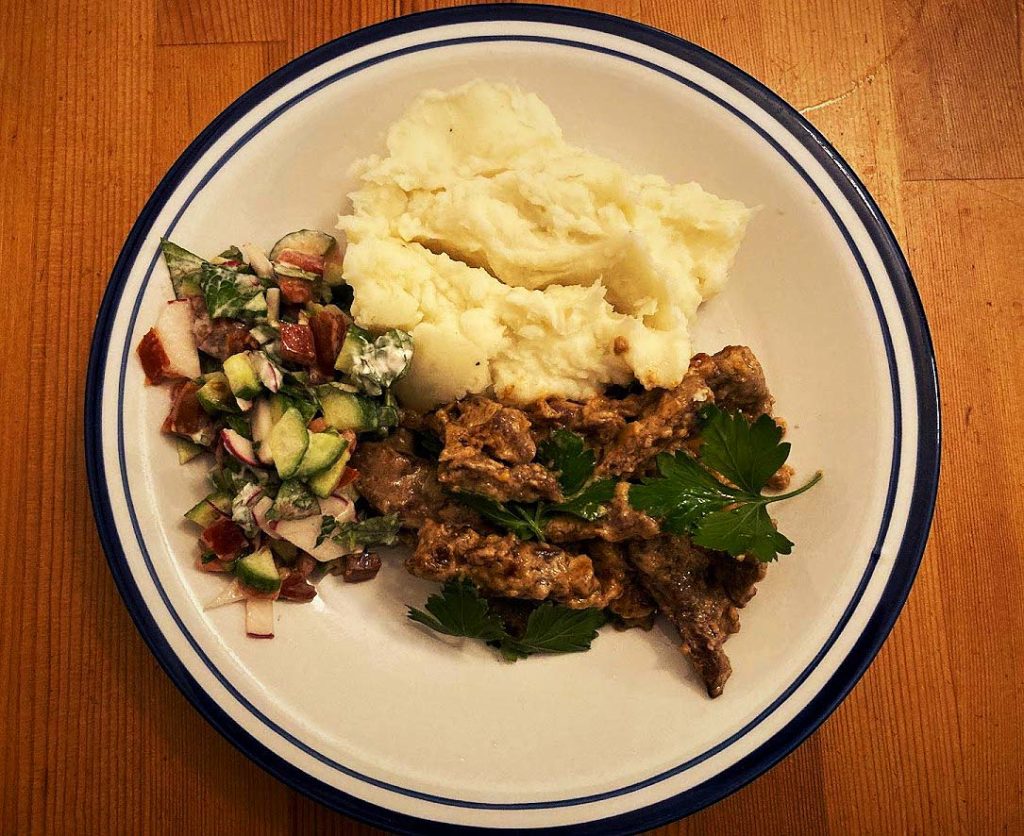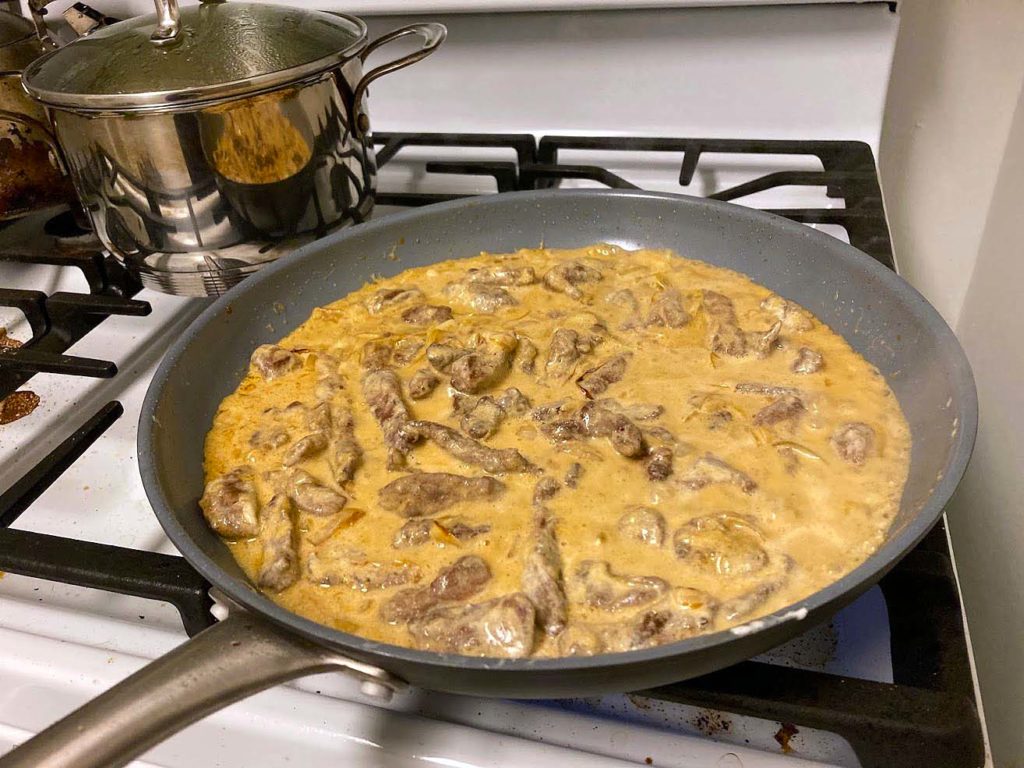Beef stroganoff is one of those national dishes (Russia, of course) that have over the years claimed international fame. It is now one of those classic dishes that are easily recognizable from Germany to South Africa. Justifiably so: what is not to love about the succulent beef cooked in creamy sauce, and served over mashed potatoes (the original Russian way) or over egg noodles (as in Europe or in the United States)? While I was making this recipe, a Colombian surprised me that in her country, this dish is even served on a large crepe. International, indeed.
Many a chef has battled over the real origin of the dish. I will tell you the story of beef stroganoff I know, as it was told by my grandma one gloomy Russian autumn evening, appropriate for comfort food.

Once upon a time, on a similarly cold and gloomy evening, a nobleman whose name was – shockingly – Stroganoff called upon his family chef and asked him to come up with a tasty dish that he could eat with his remaining old-age teeth without afterwards having to see the local dentist who lived 8 hours away.
The chef, who apparently had some French culinary training (as many nobles in those pre-Communist days required their chefs to do), had dug around his Russian kitchen and invented something approximating Frenchy stuff that his ageing employer would be happy with. And so happy it did make the good ole Stroganoff that he required to serve it to all his guests from that day on. Thus, to this day the beefy dish bears the count’s name. Although, in all fairness, the nameless chef should have gotten the credit.
Instructions
Now to the recipe. I have to warn you that it is not entirely the original recipe, but is closer to the original Russian home version than to a European or American restaurant version.
It is my version.
The key to the beef is that the result has to be relatively soft, not chewy. There are a couple of tricks you can use to do it.
Maximizing the Softness of Your Steak
First, you can (and should) use the softest cut: filet mignon. However, I understand that it can be quite pricey, so follow the below technique if you choose some other cut. Note that the technique will work with pretty much any cut of choice. I used skirt steak because I like its flavor.
Cut the beef into 1 inch strips, always against the grain. Dry the meat with a paper towel and coat it with flour. It will ensure that meat juices will stay inside the beef. This is another contributing factor to making it soft. The flour should coat the meat thoroughly, but don’t make a super-thick coating as if you were making Nashville hot chicken or something. A light coating is all you need.
Heat up your pan. Today, I used GreenPan’s Lima ceramic nonstick 12 inch skillet, which I think is excellent since you can be tough on it and has a lid that you will need for making a great beef stroganoff. Once the pan is hot, put some high-smoke oil and wait for it to start simmering.
Once the oil is hot enough, brown the beef on both sides. Make sure that you don’t crowd the pan because otherwise the pan’s temperature will drop, the beef won’t sear, and you will start losing meat juices – whether you use flour coating or not. The combination of a cooled off pan and meat juice will boil the meat rather than fry it, and will simultaneously make it tough. So, cook it in batches.
Salt and remove the beef to a separate plate to let it rest.

Prepare your veg
Meanwhile, cut the onions into thin slices (julienne), and mince the garlic. Once the pan is hot again, add the onion and the garlic and cook until they begin to caramelize. About 10 minutes.
Add the meat back in, and add the sauce. Heat it on the low heat under the lid for about 5 minutes. You are done.
And now the Sauce
The sauce is a French style béchamel, but with sour cream and (optionally) tomato paste added. To make béchamel, heat up butter on low-to medium heat and, once melted, add flour. This is called roux. Cook the roux for a couple of minutes and then add cold milk. Stir it together, bring to a point when the milk starts to steam a bit, and then on very low heat (or using a hot water bath under the pot) whisk it until smooth and ready to use. Add sour cream to the béchamel, and salt and pepper to taste. Voila!
If you want to add a sour note to the sweet cream, use tomato paste (I did not for this recipe). Add it to the onion/garlic mixture 3 minutes before they are done.
Ingredients:
1 LB of filet mignon or other steak
1 large white onion
2-3 cloves of garlic
1 tablespoon of flour
2 teaspoons of tomato paste (optional)
For the sauce:
1-2 tablespoon of butter
1.5 tablespoons of flour
¾ – 1 glass of milk, depending on how thick you want your sauce
A lot of sour cream! At least 2 tablespoons, but I use three. It is also a matter of preference.
